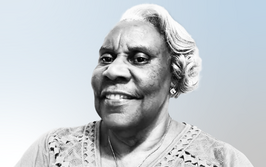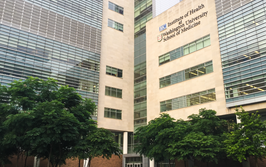Mr. Fix-It
Sitting Down With... Keith Barton, Consultant Ophthalmologist, Moorfields Eye Hospital, London, UK
What has been your most successful collaboration?
Without a doubt, working with Don Budenz; we’ve had enormously successful collaborations dating back more than 20 years. I owe the majority of my H-index to Don’s relentless hard work in research. We started working together in 1996 with the first use of amniotic membrane transplantation in glaucoma surgery, initially in rabbits and subsequently in a human randomized controlled trial. After that, we collaborated – or rather, Don did all the work and I helped! – in the ABC study (which we co-chaired), the Tema Eye Survey and the Tema Eye Survey II. In between, we were both investigators in the TVT and PTVT studies. Parenthetically (and outside of Ophthalmology), Don’s wife, Sue, rescued my 19-year-old son from a crack house in Chapel Hill!
Wait, what?
Yes. Four years ago, Don hooked my would-be medical student son up with a summer job in an HIV immunology lab in North Carolina, where he spent a few months “growing brain cells on cover slips,” as he told his mother. Said son found himself accommodation using the highly reputable “Craigslist,” but started grumbling about his party-animal housemates. The night of our first Asian Ophthalmology Futures Forum in Tokyo, at midnight (after a lot of wine), I received a call from him: he wanted to get out immediately. His housemates were always high on various substances, they partied all night every night, they never locked the doors, and so on… Sue, with 30 minutes notice, organized an actual SWAT team, who swooped in and transferred him (with all his stuff) to Chateau Budenz, where he remained!
Back to collaborations: a fruitful one of a different nature has been with Kuldev Singh and the Ophthalmology Futures Forums, which we first launched in 2012. Six European and three Asian Forums later, and it is exciting to see how they’ve grown and how they will continue to grow. This year we will host our first Retina Forum on September 19 (the evening before EURETINA).
What are the highlights of your career?
There have been many. Being asked to manage glaucoma in patients attending Moorfields’ burgeoning uveitis clinics first springs to mind; I had an instant referral base of largely young patients – the majority of whom required surgery. One of the biggest moments was convincing Pharmacia in 1999 to bring the Baerveldt Glaucoma Implant to the UK. For context, my Moorfields clinic had become a bit of a “bleb-repair shop”, with endless streams of patients returning for more and more trabeculectomy bleb fiddlings, revisions, repairs... Having access to the implant meant that we glaucoma surgeons finally had access to something that could control patients’ IOP with a high level of efficacy in complex surgical cases.
Being part of the TVT, ABC and PTVT studies was also privilege, as I was able to help contribute to the generation of a firm evidence base for the role of aqueous shunts in glaucoma surgery. Then there’s my involvement in the MIGS boom; watching glaucoma surgery – a field in which I have toiled for years – suddenly become hot and sexy, with a feeding frenzy of commercial interest, has been incredible. It’s been quite a ride these past few years!
Who do you consider your mentors?
My first in medicine was Desmond Archer, retired Chair of Ophthalmology at the Queen’s University of Belfast, a charismatic figure who by the early-to-mid 1980s had built one of the most impressive ophthalmology departments in the UK and who inspired me to take up ophthalmology. Then there was James McGill in Southampton, who told me in no uncertain terms in 1989 to apply to Moorfields. After James, there was Sue Lightman, who told me early on that I should be at a tertiary referral center and helped kick-start my career in uveitic glaucoma. John Dart taught me that surgeons can actually be very logical, scientific and, contrary to popular belief, sometimes even think a lot. Crucially, he taught me not to be scared of complex cases. Finally, Roger Hitchings, who gave me a consultant job, encouraged my entry into complex surgical glaucoma, inspired and encouraged my international career and, probably the greatest compliment, graciously permitted me to look after his private patients on his retirement.
What drives you?
Caffeine, patient’s appreciative comments after controlling the pressure in seemingly impossible cases, training surgical fellows and teaching them not to shy away from complex cases, like John and Roger did for me. Caffeine again. And the pursuit of something that is at least as effective as the Baerveldt Glaucoma Implant, that is at least as predictable as femtosecond laser-assisted cataract surgery, that doesn’t require Heath-Robinsonian systems of occluding sutures to prevent early hypotony, and that doesn’t risk endothelial cell loss, later erosion or double vision.
Barton is a Consultant Ophthalmologist and Director of The Glaucoma Service, Moorfields Eye Hospital, London, UK. His principal interests are the surgical management of glaucoma (especially with aqueous shunt devices and MIGS approaches) and secondary glaucomas – Keith runs an NHS clinic at Moorfields that’s uniquely dedicated to the management of glaucoma in uveitis. However, Keith’s skillset goes beyond surgery. He’s well known for organizing and running glaucoma educational symposia that have attracted significant acclaim, and he famously co-founded and organized (with Kuldev Singh) the Ophthalmology Futures Forum investor networking events that take place in both Europe and Asia. He was voted to #10 on the 2018 Power List.













